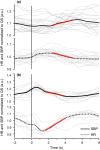Cardiovascular response to postural perturbations of different intensities in healthy young adults
- PMID: 35531916
- PMCID: PMC9082380
- DOI: 10.14814/phy2.15299
Cardiovascular response to postural perturbations of different intensities in healthy young adults
Abstract
The ability to regain control of balance is vital in limiting falls and injuries. Little is known regarding how the autonomic nervous system responds during recovery from balance perturbations of different intensities. The purpose of this study was to examine the cardiovascular response following a standing balance perturbation of varying intensities, quantify cardiac baroreflex sensitivity (cBRS) during standing perturbations, and to establish the stability of the cardiac baroreflex during quiet standing before and after balance disturbances. Twenty healthy participants experienced three different perturbation intensity conditions that each included 25 brief posteriorly-directed perturbations, 8-10 s apart. Three perturbation intensity conditions (low, medium, high) were given in random order. Physiological data were collected in quiet stance for 5 min before testing (Baseline) and again after the perturbation conditions (Recovery) to examine baroreflex stability. Beat-to-beat heart rate (HR) and systolic blood pressure (SBP) analysis post-perturbation indicated an immediate acceleration of the HR for 1-2 s, with elevated SBP 4-5 s post-perturbation. Heart rate changes were greatest in the medium (p = 0.035) and high (p = 0.012) intensities compared to low, while there were no intensity-dependent changes in SBP. The cBRS was not intensity-dependent (p = 0.402) but when perturbation conditions were combined, cBRS was elevated compared to Baseline (p = 0.046). The stability of baseline cBRS was excellent (ICC = 0.896) between quiet standing conditions. In summary, HR, but not SBP or cBRS were intensity-specific during postural perturbations. This was the first study to examine cardiovascular response and cBRS to postural perturbations.
Keywords: central command, autonomic nervous system, postural control, baroreflex.
© 2022 The Authors. Physiological Reports published by Wiley Periodicals LLC on behalf of The Physiological Society and the American Physiological Society.
Conflict of interest statement
The authors do not have any conflicts of interest to disclose.
Figures


Similar articles
-
Cardiovascular response to anticipatory and reactionary postural perturbations in young adults.Exp Physiol. 2023 Sep;108(9):1144-1153. doi: 10.1113/EP091173. Epub 2023 Jul 17. Exp Physiol. 2023. PMID: 37458232 Free PMC article.
-
Mechanisms of blood pressure control following acute exercise in adolescents: Effects of exercise intensity on haemodynamics and baroreflex sensitivity.Exp Physiol. 2018 Aug;103(8):1056-1066. doi: 10.1113/EP086999. Epub 2018 Jul 11. Exp Physiol. 2018. PMID: 29998476
-
Quiet standing after carbohydrate ingestion induces sympathoexcitatory and pressor responses in young healthy males.Auton Neurosci. 2014 Oct;185:112-9. doi: 10.1016/j.autneu.2014.07.007. Epub 2014 Aug 1. Auton Neurosci. 2014. PMID: 25129222
-
Power spectral analysis of heart rate and blood pressure: markers for autonomic balance or indicators of baroreflex control?Clin Sci (Lond). 1995 Jan;88(1):1-2. doi: 10.1042/cs0880001. Clin Sci (Lond). 1995. PMID: 7704990 Review. No abstract available.
-
Beneficial effects of physical activity on baroreflex control in the elderly.Ann Noninvasive Electrocardiol. 2014 Jul;19(4):303-10. doi: 10.1111/anec.12170. Epub 2014 May 21. Ann Noninvasive Electrocardiol. 2014. PMID: 24844457 Free PMC article. Review.
Cited by
-
The effects of slow breathing on postural muscles during standing perturbations in young adults.Exp Brain Res. 2022 Oct;240(10):2623-2631. doi: 10.1007/s00221-022-06437-0. Epub 2022 Aug 13. Exp Brain Res. 2022. PMID: 35962803
-
Cardiovascular response to anticipatory and reactionary postural perturbations in young adults.Exp Physiol. 2023 Sep;108(9):1144-1153. doi: 10.1113/EP091173. Epub 2023 Jul 17. Exp Physiol. 2023. PMID: 37458232 Free PMC article.
-
The effect of slow breathing on cardiovascular and electromyographic responses during standing perturbations in older adults.Eur J Ageing. 2025 Jun 5;22(1):26. doi: 10.1007/s10433-025-00863-z. Eur J Ageing. 2025. PMID: 40471371 Free PMC article.
References
-
- Bertinieri, G. , di Rienzo, M. , Cavallazzi, A. , Ferrari, A. U. , Pedotti, A. , & Mancia, G. (1985). A new approach to analysis of the arterial baroreflex. Journal of Hypertension. Supplement, 3, S79–S81. - PubMed
MeSH terms
LinkOut - more resources
Full Text Sources

